A mass for asymptotically complex hyperbolic manifolds
A mass for asymptotically complex hyperbolic manifolds
A mass for asymptotically complex hyperbolic manifolds
Create successful ePaper yourself
Turn your PDF publications into a flip-book with our unique Google optimized e-Paper software.
hal-00429306, version 1 - 2 Nov 2009<br />
8 A MASS FOR ASYMPTOTICALLY COMPLEX HYPERBOLIC MANIFOLDS.<br />
whose relevance will be clear from paragraph 2.2.<br />
Remark 5. The <strong>complex</strong> projective analogue (c = +1 in remark 4) of this third order<br />
equation appears in Obata’s work [Oba] : on a simply-connected manifold, it possesses<br />
a solution if and only if the manifold is the <strong>complex</strong> projective space of holomorphic<br />
sectional curvature 4.<br />
2.2. The model case. We wish to describe the case where M = CHm . We start with<br />
the <strong>complex</strong> vector space Cm+1 , m ≥ 2, endowed with the Hermitian <strong>for</strong>m defined<br />
by<br />
m<br />
< z,z >=<br />
|zk| 2 − |zm+1| 2 .<br />
k=1<br />
We denote this space by Cm,1 or R2m,2 (whose metric structure is preserved by the<br />
standard <strong>complex</strong> structure J). The level set < z,z >= −1, endowed with the restriction<br />
of is by definition the Anti-de-Sitter space, AdS2m,1 , a Lorentz manifold with<br />
constant sectional curvature −1, invariant under the natural (scalar) action of S1 on<br />
Cm+1 . The <strong>complex</strong> <strong>hyperbolic</strong> space CHm is the quotient AdS2m,1 /S1 , endowed with<br />
the induced metric :<br />
AdS2m,1 ⊂ Cm,1 π ↓<br />
CHm Let ν be the position vector field in C m+1 , identified also with the dual one-<strong>for</strong>m<br />
< ν,. >. By definition of AdS 2m,1 , < ν,ν >= −1 along AdS 2m,1 and the tangent<br />
bundle TAdS 2m,1 is exactly the orthogonal subspace to ν <strong>for</strong> . Besides, the vector<br />
field Jν is tangent to the action of S 1 and obeys < Jν,Jν >= −1. If π is the projection<br />
of AdS 2m,1 onto CH m , it follows that at each point of AdS 2m,1 , dπ is an isometry<br />
between {ν,Jν} ⊥ and the tangent space of CH m .<br />
To understand E = E(CH m ), we pick a point z in AdS2m,1 and look at the map<br />
θz : Eπ(z) −→ Λ2 JR2m,2 given by z<br />
θz(ξ,α,u) = (dπz) ∗ ξ + u(π(z)) Jν ∧ ν + ν ∧ (dπz) ∗ α + Jν ∧ J(dπz) ∗ α<br />
It is a R-linear isomorphism and we have<br />
< θz(ξ,α,u),θz(ξ,α,u) >= |ξ| 2<br />
π(z) + u(π(z))2 − 1<br />
2 |α|2<br />
π(z) = h π(z) (ξ,α,ν).<br />
Setting Ψz := θ−1 z , we obtain a bundle map Ψ that is S1-invariant and satisfies the<br />
commutative diagram<br />
Λ2 JR2m,2 Ψ<br />
−−−−→ E<br />
⏐<br />
<br />
AdS2m,1 π<br />
−−−−→ CHm In this way, in the case of CHm , the metric h preserved by ∇CH simply comes from<br />
, via Ψ. At the level of sections, Ψ yields an isomorphism<br />
⏐<br />
<br />
Γ(E) ∼ = Γ Λ 2 J R2m,2 | AdS 2m,1<br />
where the right-hand side denotes the S 1 -invariant sections of the bundle obtained by<br />
restricting Λ 2 J R2m,2 to AdS 2m,1 . This isomorphism identifies σ = (ξ,α,u) ∈ Γ(E) with<br />
S 1<br />
2<br />
.


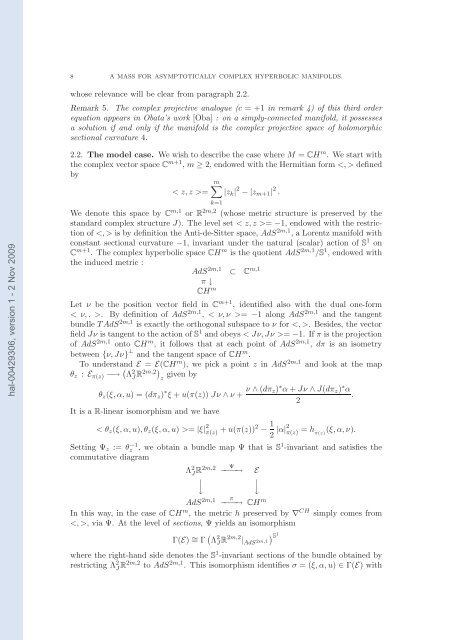

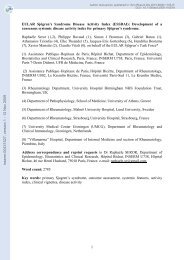
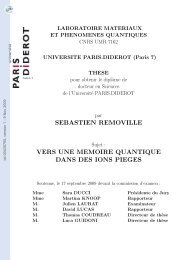
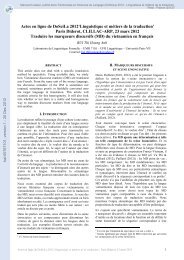
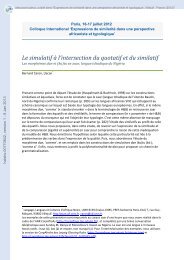
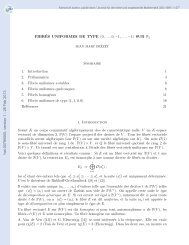
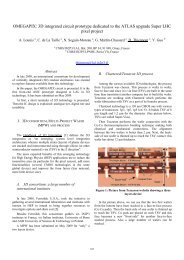
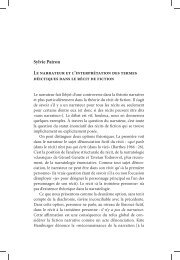
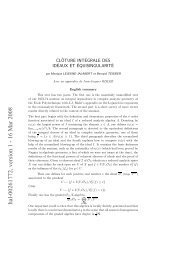
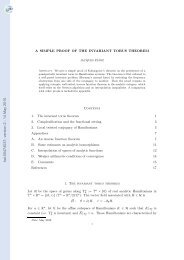

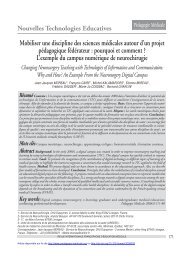

![[tel-00433556, v1] Relation entre Stress Oxydant et Homéostasie ...](https://img.yumpu.com/19233319/1/184x260/tel-00433556-v1-relation-entre-stress-oxydant-et-homeostasie-.jpg?quality=85)